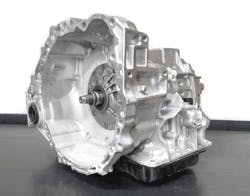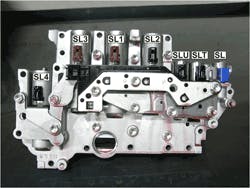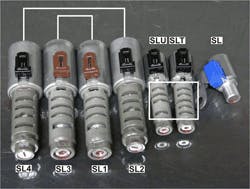Toyota’s U660E mounted to a V6 engine and the U760/1E with the L4 is a front wheel drive transmission (figure 1). It utilizes 7 solenoids to achieve 6 forward gears along with flex lock up control (figure 2). The SL1, SL2, SL3 and SL4 are clutch control linear solenoids. SL1 controls the C1 clutch, the SL2 controls the C2 clutch, the SL3 controls the B1 Brake and the SL4 controls the B3 Brake. The SLU and the SL solenoids controls flex lock up of the converter clutch while the SLT controls main line pressure.
Care must be taken when servicing the valve body as the solenoids can be easily inserted incorrectly. Here is a case where the solenoids are similar but are not the same, especially with the SLU and the SLT solenoid. They are both identical in size, they both have black color connector and the connectors are configures exactly the same. The SLU solenoid is a Normally Vented solenoid while the SLT is a Normally Applied solenoid. The only way to distinguish the difference between the two is to have them removed from the valve body (figure 3). Once removed, the difference in the number of ports in the snout of the solenoid can be observed. The SLT has 5 while the SLU has 4.If the SLU and the SLT solenoids are accidently installed, an immediate no reverse
will occur. Normally, there is a reverse inhibit strategy in place as a safety precaution. To have reverse, the B2 and the B3 clutch need to apply. If the computer thinks the vehicle is moving forward when reverse is selected, the SL solenoid turns on stroking the reverse sequence valve. This will block fluid pressure from reaching the B3 clutch causing a no reverse. However, with the SLT in the SLU location, a misrouting of pressure strokes the B2 control valve cutting off B2 clutch apply pressure.When it comes to the four clutch control linear solenoids, two have a brown connector and two have a black connector. The SL1 and SL3 have the brown connectors while SL2 and SL4 have black connectors. All four are Normally
Vented solenoids, they are all dimensionally the same and their connectors are configured the same. So what’s the difference between them other than the color of the connectors? The difference is inside the solenoid. The internal valve in the stem of the solenoid is designed differently making it visually difficult to distinguish. To facilitate a method of identification, different color connectors are used; brown and black. If one is not paying attention, different color connectors do not necessarily mean they will be inserted in their proper location. And when any of these solenoids are inserted in the wrong location, it is similar to having a connector cross connect error that can cause a days work to figure out. So when working on the U660E, remember the two browns go in the middle with a black on either side, and the SLT with 5 ports sits in-between the SLU and the SL solenoids.




